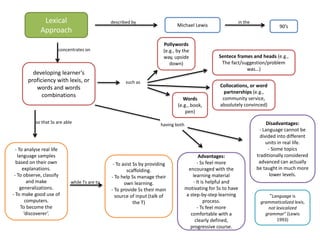Lexical approach c-map
This document summarizes the lexical approach to language teaching developed by Michael Lewis in the 1990s. The lexical approach focuses on developing students' proficiency with vocabulary, including individual words, multi-word units, collocations, and sentence frames. It aims to provide scaffolding for students and make the teacher's language the main input source. Students are encouraged to observe and classify real language samples to discover patterns themselves. The advantages are that it encourages and motivates students through a step-by-step process, and teachers feel more comfortable with a clearly defined curriculum. The disadvantages are that language cannot be perfectly divided and some topics considered advanced can actually be taught at lower levels.

Recommended
Recommended
More Related Content
What's hot
What's hot (20)
Similar to Lexical approach c-map
Similar to Lexical approach c-map (20)
More from Camila__
More from Camila__ (20)
Lexical approach c-map
- 1. Lexical Approach Michael Lewis 90’s developing learner’s proficiency with lexis, or words and words combinations Words (e.g., book, pen) Pollywords (e.g., by the way, upside down) Collocations, or word partnerships (e.g., community service, absolutely convinced) Sentece frames and heads (e.g., The fact/suggestion/problem was…) - To asist Ss by providing scaffolding. - To help Ss manage their own learning. - To provide Ss their main source of input (talk of the T) - To analyse real life language samples based on their own explanations. - To observe, classify and make generalizations. - To make good use of computers. To become the ‘discoverer’. Advantages: - Ss feel more encouraged with the learning material - It is helpful and motivating for Ss to have a step-by-step learning process. - Ts feel more comfortable with a clearly defined, progressive course. Disadvantages: - Language cannot be divided into different units in real life. - Some topics traditionally considered advanced can actually be taught in much more lower levels. concentrates on described by in the such as so that Ss are able while Ts are to having both "Language is grammaticalized lexis, not lexicalized grammar" (Lewis 1993)
